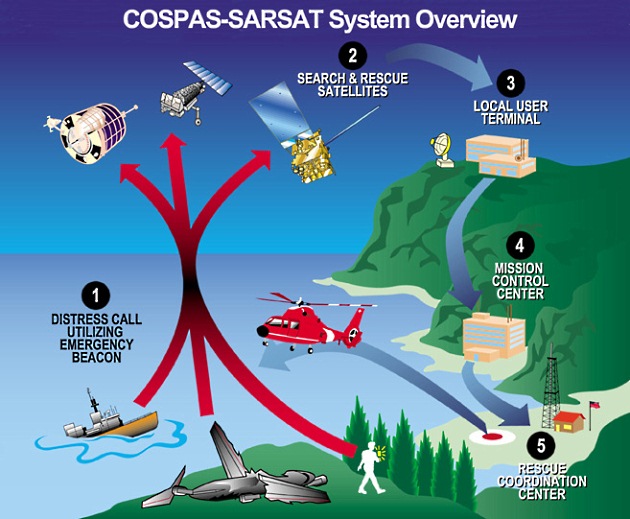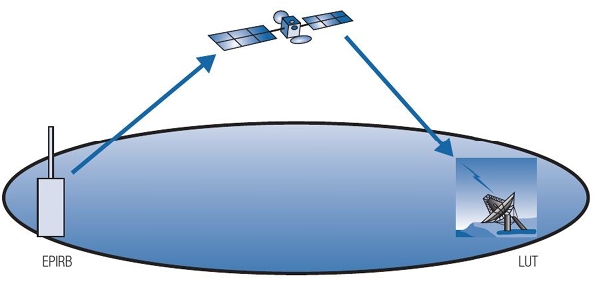EPIRBs are authorised under a class licence and as such do not require an individual radio communications licence. An EPIRB is described as a small, self-contained, battery-operated radio transmitter which is both watertight and buoyant. The signal from an EPIRB beacons is a ship to shore distress alert.
The essential purpose of an EPIRB is to assist in determining the geographic position of survivors in search and rescue operations. The EPIRB should not be considered as an alternative to an approved marine radio transceiver.
Operation of the EPIRB should be a simple two step action and, once switched on or activated, should not be switched off until rescue has been completed International Radio Regulations state that the EPIRB battery should be capable of
supplying power to the EPIRB for a minimum of 48 hours. The EPIRB signal is designed to be received by the Cospas-Sarsat System satellites. The Cospas-Sarsat System provides distress alert and location information to search and rescue (SAR) services throughout the world for maritime, aviation and land users in distress.
Local User Terminals
Stations established on land for the purpose of receiving signals from the Cospas-Sarsat satellites are known as Local User Terminals (LUTs).

Source: en.wikipedia.org
There are two LUTs in Australia, one located at Albany, in Western Australia, and another at Bundaberg. Queensland, both of which are linked to the Rescue Coordination Centre (RCC) Canberra. Another LUT located at Wellington, New Zealand, is also linked to RCC Canberra.
Type Of EPIRB
There is currently only one type of EPIRB available for use by all vessels. It operates on the UHF frequencies of 406,025 MHz or 406,037 MHz. It is commonly referred to as the 406 MHz EPIRB.
Identification of a 406 MHz EPIRB
Purchasers of a 406 MHz EPIRB are required to complete a registration form which is lodged with the Australian Maritime Safety Authority, Canberra. Each 406 MHz EPIRB has a unique identity code which is transmitted as part of its digitised signal and indicates its country of registration. RCCs around the world can therefore identify the vessel to which an activated EPIRB belongs.
The COSPAS-SARSAT International Satellite System
The Cospas-Sarsat satellite system is an international consortium of The United States of America. Canada, France and Russia designed to locate an activated EPIRB operating on a 406 MHz frequency. The system uses four low earth Exploring the Future of Satellitesorbiting satellites, LEOS, each making a complete low earth POLAR ORBIT at between 700 and 1 000 km altitude, in approximately 100 minutes.
At least one of these orbiting satellites is in line of sight of any point on the earth’s surface at a maximum interval of three hours. Orbiting satellites in the Cospas-Sarsat system have a viewing range, or footprint, approximately 2 000 km either side of its track across the surface of the earth.
Read also: Loran-C Position Determination and Accuracy
The system also uses five satellites that are GEO STATIONARY, in fixed positions, some 36 000 km above the equator.
Methods of Detection and Location
The 406 MHz EPIRB
The 406 MHz EPIRB transmits a short burst of digital data on the frequencies of 406,025 MHz, 406,028 MHz and 406,037 MHz. This burst of data is typically a 5 watt signal of 0,5 of a second duration every 50 seconds.
The 406 MHz EPIRBs manufactured to Australian specifications also transmit on 121,5 MHz for aircraft homing purposes. Transmission on 121,5 MHz simultaneously radiates a continuous series of distinctive descending tones which contain no station identification.
The 406 MHz EPIRB is therefore capable of being detected by:
- aircraft within range AND monitoring the civil aviation frequency of 121,5 MHz; and
- satellites operating in the Cospas-Sarsat system.
Detection by Satellite
Satellites monitoring 406,025 MHz can receive the digitised burst of data and relay the signal back to earth in the “real time” mode, as long as the EPIRB and LUT are in the satellite footprint at the same time. Because signals from a 406 MHz EPIRB are in a digitised form, they can also be stored in the satellite’s memory.
As the satellite’s path brings it into view of an LUT, information, including time of first detection, is retrieved from the satellite’s memory and relayed down to the LUT. This information is processed and passed to a rescue co-ordination centre, providing both an alert and a position. This is said to be in the “Global” mode. Position accuracy is better than 5 km (2,7 nautical miles).

EPIRBs operating on 406,028 and 406,037 MHz operate in a similar manner to the 406,025 MHz EPIRB. However, the 406,028 and 406,037 MHz EPIRBs also have an inbuilt Global Position System (GPS) unit installed. Once activated, the GPS unit can receive position information from GPS satellites and within 5 minutes include that information in the burst of data that is received by the LUT, which is then relayed to the RCC. Position accuracy is within 150 metres of the activated EPIRB.
Activation of the 406 MHz EPIRВ
Two types of 406 MHz EPIRBs are manufactured:
- those requiring manual activation, the controls of which may simply be on or off; and
- those that can be activated manually in addition to being kept in a float free bracket and released automatically by way of a hydrostatic release system. This type may also offer the operator the choice of “off“, “on“, “auto” and a “testing” facility.
Accidental Activation of an EPIRB
The RCC should immediately be advised by telephone. 1800 641 792 (24 hour service) or, if at sea, via a Coast Radio Station, a Limited Coast Station or another vessel. If the owners of an EPIRB discover that it has accidentally been activated. There are no penalties for advising of accidental activation of an EPIRB.
It will be interesting: Inmarsat M & B: Understanding the System and its Services
Servicing of EPIRBs
An EPIRB must not be tested except strictly in accordance with manufacturer’s instructions. Owners of EPIRBs should refer to the relevant regulation concerning performance verification tests and the owner’s manual concerning servicing and recommended battery replacement dates. Hydrostatic release mechanisms should be inspected and serviced at regular intervals.
Stowage of EPIRBs
EPIRBs should be stowed in a safe, easily accessible position, or in a secure float free bracket.

